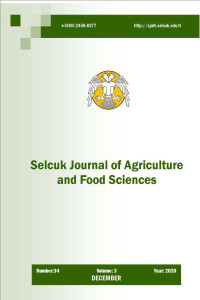Identification and Characterization of White Mold Disease (Sclerotinia sclerotiorum) in Globe Artichoke
Öz
Globe artichoke (Cynara scolymus L.) is an economically important plant that is cultivated over 30 countries in the world. In 2017, wilting and lodging symptoms were observed on globe artichoke plants in three locations (Serik-Gebiz, Serik-Karadayı and Gazipaşa-Bakılar) in the Western Mediterranean Region of Turkey. To determine the cause of the symptoms, samples from necrotic tissues were cultured in vitro. Based on the morphological and ITS sequences, the causal agent was identified as Sclerotinia sclerotiorum (Lib.) de Bary. Pathogenicity test was conducted using cv. Bayrampaşa in the greenhouse. Three isolates (Ser3, Ser4 and Gzp3) of S. sclerotiorum were characterized on the basis of mycelial compatibility, colony radial growth, sclerotia formation, sclerotia size, sclerotia weight and sclerotia number. Virulence of the isolates was also determined using detached leaf technique. No mycelial compatibility was detected among the isolates. Significant (P<0.01) differences were found in the examined morphological features and virulence of the isolates. Gzp3 was the most virulent isolate forming average 8.60 cm lesion length. However, lesion lengths formed by the other isolates, Ser3 and Ser4, were average 4.16 and 1.93 cm, respectively. This is the first detailed characterization of S. sclerotiorum causing crown and stalk rot in globe artichoke.
Anahtar Kelimeler
Ayrıntılar
| Birincil Dil | İngilizce |
|---|---|
| Konular | Bitki Bilimi |
| Bölüm | Araştırma Makalesi |
| Yazarlar | |
| Yayımlanma Tarihi | 25 Aralık 2020 |
| Gönderilme Tarihi | 31 Ağustos 2020 |
| Yayımlandığı Sayı | Yıl 2020 Cilt: 34 Sayı: 3 |
Selcuk Journal of Agriculture and Food Sciences Creative Commons Atıf-GayriTicari 4.0 Uluslararası Lisansı (CC BY NC) ile lisanslanmıştır.


